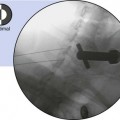Chapter 1 Introduction
How to Use This Atlas
Note: Please see page ii for a list of anatomical terms/abbreviations used in this book.
Fluoroscopic Views
 Trajectory View: “Setup Is Key”
Trajectory View: “Setup Is Key”
The trajectory view, which is also known as the hubogram, hub view, needle view, down-the-barrel, or coaxial view, provides the initial orientation for needle placement and advancement. In this view, the interventionalist directly visualizes the needle’s path to the final target. Instead of estimating the needle’s trajectory, an unobstructed needle pathway is visualized, and an associated needle entry point is identified (Figure 1–1). An initial trajectory view can be identified for almost all procedures found in this atlas. The trajectory view is typically used only for initial setup and needle placement. On occasion, the trajectory view can also be one of the final multiplanar views.
To effectively use the trajectory view, the needle is placed parallel to the direction of the fluoroscopic beam (i.e., perpendicular to the image intensifier’s surface), and a coaxial image of the needle is obtained (Figure 1–2
Stay updated, free articles. Join our Telegram channel

Full access? Get Clinical Tree





